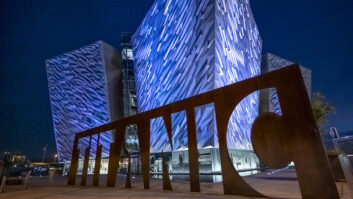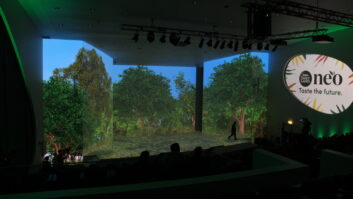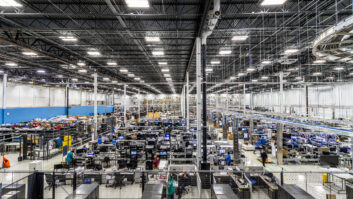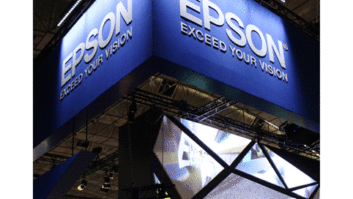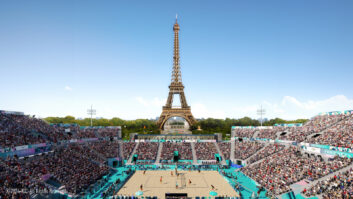If a group of integrators and consultants had been invited to jot down what they felt were the main design trends shaping the professional projector market before Covid-19, the chances are that their responses would have been pretty uniform. Along with the continued rise to prominence of laser projectors, many would have noted the shift towards higher and higher brightness, and the desire for reduced footprint – both in terms of physical size and environmental impact.
Emerging from the other side of the pandemic, it’s clear that all of these observations still hold true but can now be seen with an even sharper focus. In particular, the evidence of accelerating climate change and the huge increases in energy prices during the past two years have underlined the importance of projector solutions that are energy-efficient and supportive of a long lifespan. From the consumer perspective, there also needs to be a transparent roadmap with regard to what happens
to the projector at the end of its life.
 Hartmut Kulessa, senior marketing manager at Panasonic Connect Europe, comments: “Without compromising on brightness and image quality, end-users have also started to consider the wider environmental impact of the products they use; this impacts their overall carbon footprint and enables them to meet ever-stringent corporate social responsibility and environmental, social and governance guidelines. [This awareness] includes everything from energy efficiency and power consumption to noise pollution, and their overall investment and TCO in the projectors they use.”
Hartmut Kulessa, senior marketing manager at Panasonic Connect Europe, comments: “Without compromising on brightness and image quality, end-users have also started to consider the wider environmental impact of the products they use; this impacts their overall carbon footprint and enables them to meet ever-stringent corporate social responsibility and environmental, social and governance guidelines. [This awareness] includes everything from energy efficiency and power consumption to noise pollution, and their overall investment and TCO in the projectors they use.”
DOMINANT TRENDS
Mark Wadsworth, vice-president of global marketing at Digital Projection, provides a very concise overview of the background to the dominant design trends of recent years. “High brightness and brilliant colours are the two major features of professional projectors, and the light source is the key issue here in attaining these goals,” he says. “To this end, high power (>4000W) mercury discharge lamps and xenon lamps (1,000W-15,000W) were the only two options in this market sector for over ten years.”
Concerns over environmental impact, lifespan and efficiency – “an alternative needed to be found” – were addressed from 2010 onwards with the global development of Solid State Illumination (SSI). “One of the unique features of SSI is that the laser power is additive,” says Wadsworth. “It means that by integrating more and more laser powers into the light module, the brightness of the projector gets higher and higher.” Light source lifespans of circa 20,000 hours also mean that they are “more environmentally-friendly as they last much longer and do not need to be disposed like the mercury-based lamps mentioned earlier,” according to Wadsworth.
Today, the market is particularly well-served by LED, LCD and laser projectors. The drive towards greater energy efficiency would suggest that the long-term shift towards laser-based solutions will gradually accelerate, although the other types’ continued popularity across sectors and applications will ensure they remain critical to the market for years to come.
POWER FOCUS
If the long-term drift towards higher brightness is in no doubt, the same can be said of increased power efficiency. Noting the prominence of the issue for the past ten years, Wadsworth says that “with spiralling energy prices, it is even more in focus. Now that it has become the key topic in every household, the requirements for power efficient, sustainable products will only grow – and at a faster rate”.
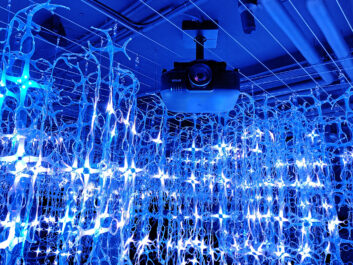 It’s no surprise, therefore, to see evidence of efficiency-boosting refinements across the full spectrum of projector types. For example, notes Kulessa, Panasonic’s “soon-to-be-released ultra-short throw PT-CMZ50 LCD projector’s new high-efficiency optical engine improves watts-per-lumen efficiency by about 25%, compared to lamp-based short-throw models.”
It’s no surprise, therefore, to see evidence of efficiency-boosting refinements across the full spectrum of projector types. For example, notes Kulessa, Panasonic’s “soon-to-be-released ultra-short throw PT-CMZ50 LCD projector’s new high-efficiency optical engine improves watts-per-lumen efficiency by about 25%, compared to lamp-based short-throw models.”
The impulse towards adoption of laser-based solutions – such as those provided by Panasonic’s SOLID SHINE technology – is also easily comprehended. “Laser technology has reduced average power consumption of projectors with a similar brightness by around 30%,” says Kulessa. “When compared to Panasonic’s PT-RQ50K laser projector, LED projectors require 2-3 times more power just to deliver the same level of image brightness. Furthermore, Panasonic’s 20,000lm PT-RQ25K projector uses about 40% less energy than predecessors that feature traditional lamp technology, while delivering the same brightness and increased wattage efficiency.”
For Digital Projection, Wadsworth recalls: “An engineering team was built with our parent company, Delta Electronics, in 2011, dedicated to the development of SSI technology used in projectors. Their key aim was to improve the power module efficiency, increase optical throughput and develop advanced cooling systems, with one aim – to make our projectors more efficient. To this end, the Digital Projection/Delta team has been awarded over 150 patents globally to protect their IP on solid state illumination technology.”
MARKET PROFILE
The extent to which this area of technology continues to evolve, even as its market profile looks increasingly assured, is underlined by Robert Meakin, senior European product marketing manager at Sony Professional Europe. Noting that the company is now on its 9th gen of laser-based business projectors, he says it has long been clear from a sustainability perspective that “the lasers last longer, [and from an energy perspective have been] getting better and better with every generation. One of our big messages at ISE was that sustainability is one of the big things that Sony is now addressing, [hence our move to] now only produce and manufacture laser-based projectors”.
Along with efficiency, the importance of form-factor – and, ideally, the continual reduction, thereof – was also in evidence at ISE 2023. In the case of Sony, this trend has manifested itself in what it describes as the “world’s smallest WUXGA 3LCD laser projectors, the VPL-PHZ51 and VPL-PHZ61, that combine advanced operational capabilities with high brightness and flexible installation”.
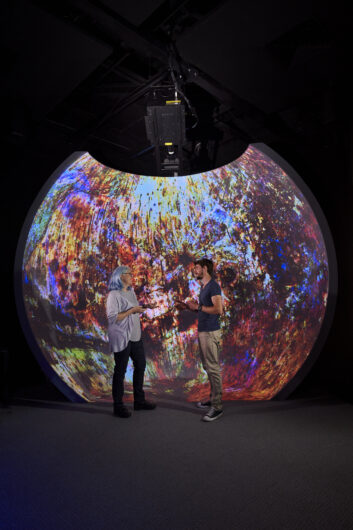 Efficiency and compact form-factor are also a priority for Epson, which introduced its EB-PQ2000 projector series at ISE 2023. According to the company, the new range builds on the success of Epson’s PU2200 line of high lumens 3CD projectors, which are 60% smaller and 50% lighter than their predecessor (EB-L20000U).
Efficiency and compact form-factor are also a priority for Epson, which introduced its EB-PQ2000 projector series at ISE 2023. According to the company, the new range builds on the success of Epson’s PU2200 line of high lumens 3CD projectors, which are 60% smaller and 50% lighter than their predecessor (EB-L20000U).
Graeme Davidson, Epson business unit for video projection, remarks that issues around efficiency and sustainability are “increasingly at the forefront of people’s minds” – a trend that is manifested in everything from their “CSR responsibilities to their purchasing decisions. People do want durable solutions, and of course energy costs are also a major consideration now.” He adds that the desire of professional users to invest in new equipment is “still there, but [due to the current climate] purchases are very considered now”.
FORM FACTOR
Along with power efficiency and form factor, vendors also commonly cite a desire to both reducing and pre-empt maintenance. So, in addition to providing filters and light-sources that can operate for longer without any attention being required, there is an emphasis on feature-sets that can detect potential problems before they develop.
Kulessa remarks: “End-users want early warning and remote monitoring systems – the latter of which enables predictive maintenance to be carried out – included as part of any investment. This means expensive problems can be avoided before they happen. Furthermore, remote monitoring/maintenance and post-sales support, which contribute towards the overall efficiency of running the projector – in turn reducing the churn rate of replacement projectors being needed – will continue to prove popular.”
Several interviewees also indicate that modularisation will be another important element of streamlining projectors’ power and maintenance requirements. “With SSI it is possible, particularly for professional projectors, to separate the light module from the optical engine, such as in [Digital Projection’s] Satellite Modular Laser System,” says Wadsworth. “A remote light module has many advantages: easy maintenance, quite operation, and small projection head that draws very little power, hence needs very little cooling – which further reduces the power requirements and requirements for thermal enclosures that would also draw power.”
Increasingly, projectors will also be perceived – by vendors and customers – in the context of economic circularity. Asked to consider the next leap forward for professional projectors, Kulessa nominates a move to a more circular economy. “This is a two-fold approach; on one hand, it’s imperative that organisations have an effective product lifecycle management strategy in place that will enable materials from existing products to be ‘re-manufactured’ into new hardware, instead of being disposed of,” he says. “It’s also important that the overall product lifecycle is extended for as long as possible without compromising performance or reliability.”
ROBUST MARKET
If all of these concerns represent a not insignificant challenge to vendors seeking to remain one step ahead, it’s reassuring to learn from Freddie Mossop – market analyst at Futuresource Consulting – that the underlying fundamentals of the market remain robust, in both technological and geographical terms.
So while LED screens and display walls are growing in popularity, there are still many instances in which “it is easier to replace a projector with a projector, rather than install a new technology that [the customers/end-users] are not familiar with.” And on a worldwide level, there are still great opportunities to be made in the market. “For instance, a country such as India has a huge population and is predicted to become the most populous country in the world [this year, overtaking China],” he says. “There is a big centralised push going on in the education system, which has a large appetite for projection technology.”
With new global prospects opening up to a sector that is increasingly willing to innovate in line with raised expectations for efficiency and sustainability, projection looks poised to enjoy a highly fertile phase.
